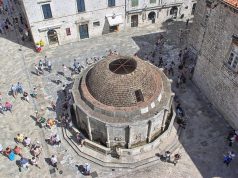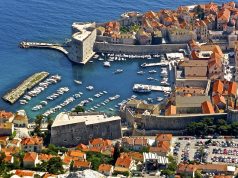
In this article you’ll find related links that will help you to plan the best trip to Split, free coupons save a lot of money on hotels, car rentals, restaurants and attractions in Zagreb, best hotels in Zagreb
Welcome to Pula, Croatia! This charming city is not only known for its stunning beaches and crystal-clear waters, but also for its rich history and impressive landmarks. Join me today as we explore the historical landmarks of Pula and dive into the fascinating stories behind these iconic sites.
1. Pula Arena
Our first stop is the Pula Arena, the most well-known landmark in the city. This impressive amphitheater was built during the 1st century AD and is one of the six largest Roman arenas in the world. As we walk through the grand arches and take in the breathtaking view of the arena’s interior, it’s easy to imagine the gladiatorial contests and other events that once took place here. The Pula Arena is still in use today, hosting concerts, film festivals, and other cultural events, making it a vibrant and lively part of the city’s modern-day life.
2. Temple of Augustus
Next, we’ll make our way to the Temple of Augustus, a beautifully preserved Roman temple dedicated to the first Roman emperor, Augustus. Built between 2 BC and 14 AD, this exquisite temple is a testament to the architectural mastery of the ancient Roman civilization. As we marvel at its intricate carvings and elegant columns, we can’t help but feel a sense of awe at the craftsmanship and dedication that went into creating this magnificent structure.
3. Pula Castle
Our journey continues to Pula Castle, a medieval fortress that dates back to the 17th century. Situated on a hill overlooking the city, the castle offers stunning panoramic views of Pula and its surrounding landscape. As we walk through its ancient walls and explore its hidden nooks and crannies, we can almost feel the echoes of history reverberating through the cobblestone paths. The castle also houses a historical museum, which provides a deeper insight into the city’s past and the significance of the castle in its defense and development.
4. Arch of the Sergii
Our final stop is the Arch of the Sergii, a triumphal arch dedicated to the Sergii family, a prominent Roman family in Pula. Built in the 1st century BC, this arch is a prime example of Roman architecture and stands as a testament to the city’s rich cultural heritage. As we stand in its shadow and take in the intricate details of its reliefs and inscriptions, we can’t help but admire the craftsmanship and artistry that went into creating this impressive structure.
FAQs
Q: How do I get around Pula to visit these historical landmarks?
A: Pula is a relatively small city, and most of the historical landmarks are within walking distance of each other. However, if you prefer to save time and energy, you can also use the city’s public transportation system, which consists of buses and trams. Taxis are also readily available for those who prefer a more direct mode of transportation.
Q: Is there an entrance fee to visit these historical landmarks?
A: Yes, there is an entrance fee for some of the historical landmarks, such as the Pula Arena and the Temple of Augustus. However, many of the city’s landmarks can be admired from the outside without having to pay an entrance fee. It’s best to check the official websites of each landmark for up-to-date information on opening hours and entrance fees.
Q: Are there guided tours available for these historical landmarks?
A: Yes, there are guided tours available for most of the historical landmarks in Pula. These tours can provide valuable insight and information about the history and significance of each site. Guided tours are a great way to enhance your experience and gain a deeper understanding of the cultural and historical context of the landmarks.
Q: Are these historical landmarks accessible for visitors with disabilities?
A: Many of the historical landmarks in Pula are accessible to visitors with disabilities, with ramps and elevators available to facilitate mobility. However, it’s advisable to check with the specific landmark’s accessibility information beforehand to ensure a comfortable and enjoyable visit.
In conclusion, Pula is a city steeped in history, and its historical landmarks offer a window into the ancient past of this beautiful region. Whether you’re a history buff or simply enjoy exploring new cultures, a visit to Pula’s historical landmarks is a must-do when visiting this enchanting city. I hope this guide has inspired you to embark on your own historical journey through Pula and experience the magic of its ancient treasures. Happy exploring!







